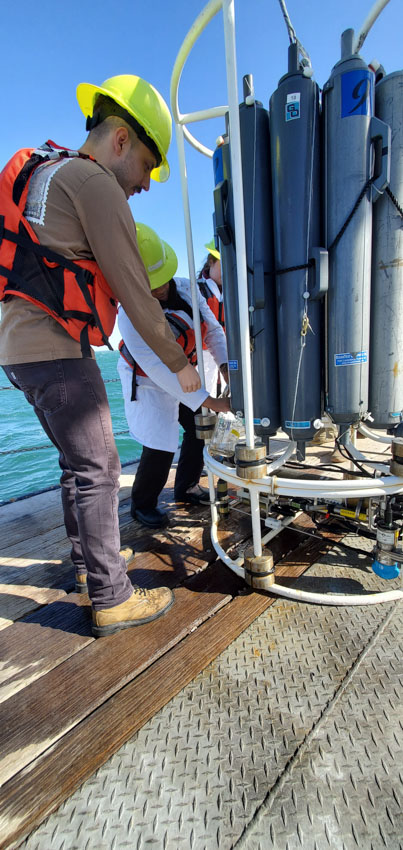USM Students Gain Invaluable Knowledge, Skills During Memorable Marine Science Cruise
Tue, 02/06/2024 - 11:36am | By: Gabriela Shinskie

Undergraduate students in the University of Southern Mississippi’s (USM) School of Ocean Science and Engineering (SOSE) have unique opportunities to prepare them for work in the blue economy, including through a partnership with the United States Environmental Protection Agency (EPA) conducting field work in the Gulf of Mexico.
Dr. Jennifer Walker, associate dean for Coastal Operations in the College of Arts and Sciences, is a partner in this effort, helping students to excel in the world of marine science and biology through an intersession course emphasizing shipboard field and laboratory research that took place aboard the R/V Point Sur. For five days after the vessel left the Port of Gulfport and sailed toward Tampa, Fla., those aboard were immersed in marine biology, chemistry, biology, geology and an experience of a lifetime.
“I want our students to have more experience with techniques. If they go to graduate school or work for an agency, they are expected to know how to do some of these things,” Dr. Walker said.

Dr. Walker didn’t have the same experience with hands-on shipboard work when she was an undergraduate student. But as a professor, she’s utilizing the many resources at USM to give her students an opportunity to gain skills that will help them obtain future work in marine science and biology. Through her intersession class, the cruise is offered twice a year to juniors and seniors, with a maximum of eight students who can participate in the cruise aboard the R/V Point Sur.
Karina Ledezma, a senior majoring in marine science, attended two research cruises. She describes the experience as an unforgettable part of her life along with the skills she gained.
“This opens a lot of doors,” Ledezma said. “I’ve had so many opportunities open because I got to do this trip. It makes students more well-rounded because they get to learn new techniques.”
Ledezma described embarkation day as one filled with safety drills and a run-through of the week ahead. Roommates are assigned along with opportunities to network aboard the vessel.
“It’s a good mix of everything we get to learn,” Ledezma explained. “Every day we got to rotate through each activity and socialize. It’s a good networking opportunity. Each day had its own plan.”

As the cruise advanced toward the West Florida Escarpment, students participated in daily activities that included working with conductivity, temperature, and depth (CTD) equipment to measure temperature and salinity. Students were also able to send a Styrofoam cup inside a mesh bag thousands of feet beneath the sea. The deeper the cup sunk toward the ocean floor, the more pressure was applied, allowing the cup to shrink in size. The deepest depth that a Styrofoam cup has been sent during one of the intersession cruises is 9,512 feet.
“We do this to demonstrate how depth influences objects and so the students have something to take home with them,” said Dr. Walker. “Everyone likes the cup.”
As the cruise continued, students adapted to weather conditions at sea and were able to observe ecosystems within marshes and observe sea grass beds after debarking from the vessel to snorkel. At the end of the cruise, the students presented the results of their research along with reflections of their time aboard the Point Sur.
Dr. Walker plans to continue the intersession course and cruises in 2024, with a focus on microplastics and observations of in-shore and offshore water nutrient levels. She also wants to examine the density of urchins and other organisms in grass beds and marsh habitats along the Florida coast, with the findings from these surveys to potentially be used in future research.
Natalie Santiago, a senior in marine biology, plans to find a career in field work at sea after she graduates from USM in May 2025.
“It provided hands-on experiences for students working with various equipment and about the scientific process that goes into fieldwork, as well as an overall understanding of working on a scientific research vessel,” Santiago said.
The partnership with EPA has allowed USM students to acquire internships along with other research opportunities. For Ledezma, her cruise experience landed her two internships and confidence in working out at sea.
“I encourage any student to do this trip, because it’s worth it,” she said.
Learn more about how USM students, faculty and staff are focusing on future work in the blue economy.